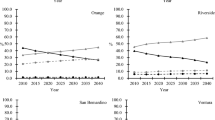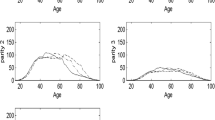Abstract
The Hamilton–Perry method, which uses cohort change ratios (CCR) and child-woman ratios (CWR), has gained acceptance as research has demonstrated its practical value and accuracy in forecasting population composition. Assessments of this method have been based on the usual assumption that CCRs and CWRs developed over the base period are held constant over the forecast horizon. We propose several approaches for modifying CCRs and CWRs over the forecast horizon. These alternatives are averaging and trending these ratios and a synthetic method that bases local CCRs and CWRs changes on state-level changes in CCRs and CWRs. We evaluate the errors for these alternatives against the errors holding the CCRs and CWRs constant for counties in Washington State and for census tracts in New Mexico. The evaluation suggests that averaging or trending CCRs and CWRs are not worthwhile strategies, but the synthetic method reduces errors compared to holding the ratios constant over the horizon.





Similar content being viewed by others
Notes
CWRs (children/woman of childbearing years) represent the typical application of the Hamilton-Perry method for forecasting the youngest age groups. Other approaches could be used such as age-specific fertility rates (Swanson et al. 2016) or the ratios of the children at two points in time (Swanson and Tayman 2014).
Smith and Tayman (2003) found that while uncontrolled HP forecasts generally had larger errors than the controlled forecasts for all states and counties in Florida, the pattern of errors by age groups was generally very similar for both the controlled and uncontrolled forecasts.
We analysed separate projections for males and females, but do not report the results here because of space limitations. Forecast errors for males and females were similar for most age groups and the total population. For ages 65 years and older, females generally had greater accuracy and lower bias.
For readers interested in an older terminal age group, we computed forecast errors for persons aged 85 years and older. For both accuracy and bias, the patterns are similar to those seen in the 75+ age group in Table 3. MALPEs for SYN (−0.2%) and CONST (−2.1%) are smaller than those for AVG (−4.5%) and TREND (4.9%), and MAPEs for SYN (10.3%) and AVG (11.4) are smaller than those for CONST (12.1%) and TREND (16.3%).
To conserve space we do not present comparisons of SYN with AVG and TREND. To summarize these results, SYN had smaller APEs in more counties than AVG in six age groups, with percentages ranging from 51.3 to 74.4%. For ages 10–19, SYN had a lower MAPE in 48.7% of the counties. SYN also had smaller IODs than AVG in more counties (64.1%). SYN had smaller APEs than TREND in more counties in all age groups with percentages ranging from 69.2 to 92.3%. In terms of allocation error, SYN had a lower IOD than TREND in 92.3% of the counties.
For persons aged 85 years and older, the levels of bias and accuracy are much higher than for ages 75+ with SYN outperforming CONST. MALPEs for SYN and CONST are 76.2 and 82.3% respectively and the corresponding MAPEs are 106.0 and 110.5%.
We analysed forecast errors by size and growth rate for each age group, but do not present these results to save space. The results for all groups were very similar to those for total population.
We also prepared two other forecasts for Washington’s counties using 1990 as the launch year and 2000 (10-year forecast) and 2010 (20-year forecast) as horizon years. The 10-year forecasts showed CONST with slightly smaller forecasts errors compared to AVG, but the 20-year forecasts showed the errors in AVG are considerably larger than the errors in CONST.
References
Baker, J., Alcantara, A., Ruan, X., Watkins, K., & Vasan, S. (2014). Spatial weighting improves accuracy in small area demographic forecasts of urban census tract populations. Journal of Population Research. doi:10.1007/s12546-014-9137-1.
Baker, J., Swanson, D. A., Tayman, J., & Tedrow, L. M. (2017). Cohort change ratios and their applications. Dordrecht: Springer.
Duncan, O. D., Cuzzort, R. P., & Duncan, B. (1961). Statistical geography: Problems in analyzing area data. Glencoe: Free Press.
Massey, D. S., & Denton, N. A. (1988). The dimensions of residential segregation. Social Forces, 67, 281–315.
Office of Financial Management. (2002). Washington State county population projections for growth management by age and sex 2000–2025. Olympia, WA: OFM Population Division.
Rayer, S. (2007). Population forecast accuracy: does the choice of summary measure of error matter? Population Research and Policy Review, 26, 163–184.
Smith, S. K., & Rayer, S. (2012). Projections of Florida population by county, 2011–2040. Florida Population Studies, Bulletin 162. Gainesville: Bureau of Economic and Business Research, University of Florida.
Smith, S. K., & Shahidullah, M. (1995). An evaluation of population projections errors by census tract. Journal of the American Statistical Association, 90, 64–71.
Smith, S. K., & Tayman, J. (2003). An evaluation of population projections by age. Demography, 40(4), 741–757.
Smith, S. K., Tayman, J., & Swanson, D. A. (2013). A practitioner’s guide to state and local population projections. Dordrecht: Springer.
Swanson, D. A. (2015). On the relationship among values of the same summary measure of error when it is used across multiple characteristics at the same point in time: An examination of MALPE and MAPE. Review of Economics and Finance, 5(1), 1–14.
Swanson, D. A., Schlottmann, A., & Schmidt, R. (2010). Forecasting the population of census tracts by age and sex: An example of the Hamilton–Perry method in action. Population Research and Policy Review, 29, 47–63.
Swanson, D. A., & Tayman, J. (2014). Measuring uncertainty in population forecasts: A new approach employing the Hamilton–Perry method. presented at british society for population studies conference, Winchester, UK, 8–10 September.
Swanson, D. A., & Tayman, J. (2016). A long term test of the accuracy of the Hamilton–Perry method. In D. Swanson (Ed.), New frontiers of applied demography (pp. 491–513). Dordrecht: Springer.
Swanson, D. A., Tayman, J., & Bryan, T. (2011). MAPE-R: A rescaled measure of accuracy for cross-sectional, sub-national forecasts. Journal of Population Research, 28, 225–243.
Swanson, D. A., Tayman, J., McKibben, J., & Cropper, M. (2012). A “blind” ex post facto evaluation of total population and total household forecast for small areas made by five vendors for 2010: Results by geography and error criteria. Presented at the 2012 Canadian Population Society Conference, Waterloo, Canada, 30 May–1 June.
Swanson, D. A., Tedrow, L. M., & Baker, J. (2016). Exploring stable population concepts from the perspective of cohort change ratios: Estimating the time to stability and intrinsic r from initial information and components of change. In R. Schoen (Ed.), Dynamic demographic analysis (pp. 227–258). Dordrecht: Springer.
Williamson, P. (2013). An evaluation of two synthetic small area microdata simulation methodologies: Synthetic reconstruction and combinatorial optimisation. In R. Tanton & K. L. Edwards (Eds.), Spatial microsimulation: A reference guide for users (pp. 227–258). Heidelberg: Springer.
Wilson, T. (2016). Evaluation of alternative cohort-component models for local area population forecasts. Population Research and Policy Review, 35, 241–261.
Author information
Authors and Affiliations
Corresponding author
Rights and permissions
About this article
Cite this article
Tayman, J., Swanson, D.A. Using modified cohort change and child-woman ratios in the Hamilton–Perry forecasting method. J Pop Research 34, 209–231 (2017). https://doi.org/10.1007/s12546-017-9190-7
Published:
Issue Date:
DOI: https://doi.org/10.1007/s12546-017-9190-7




